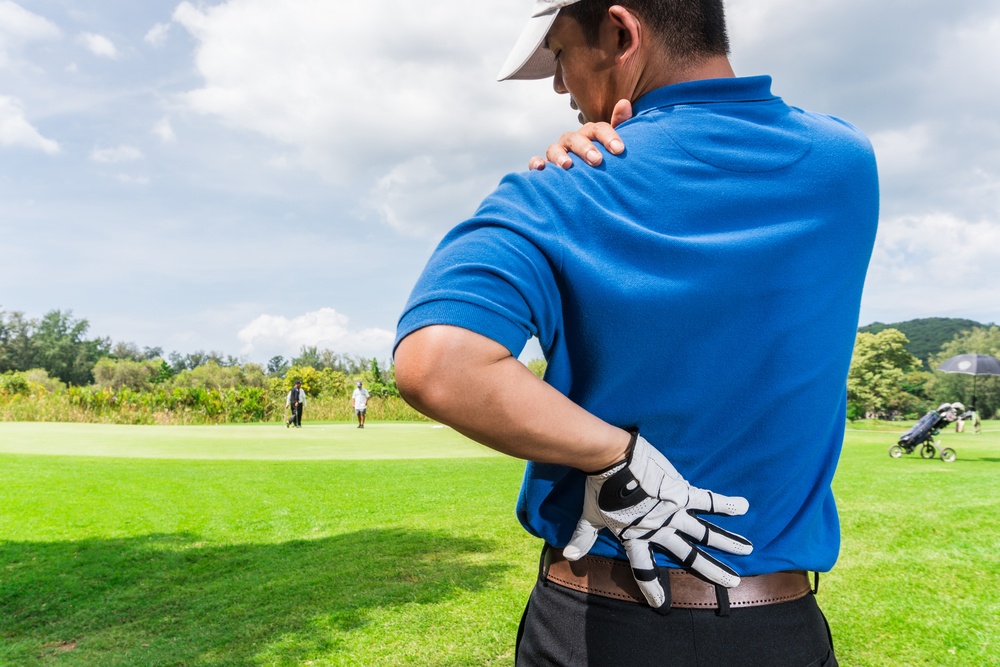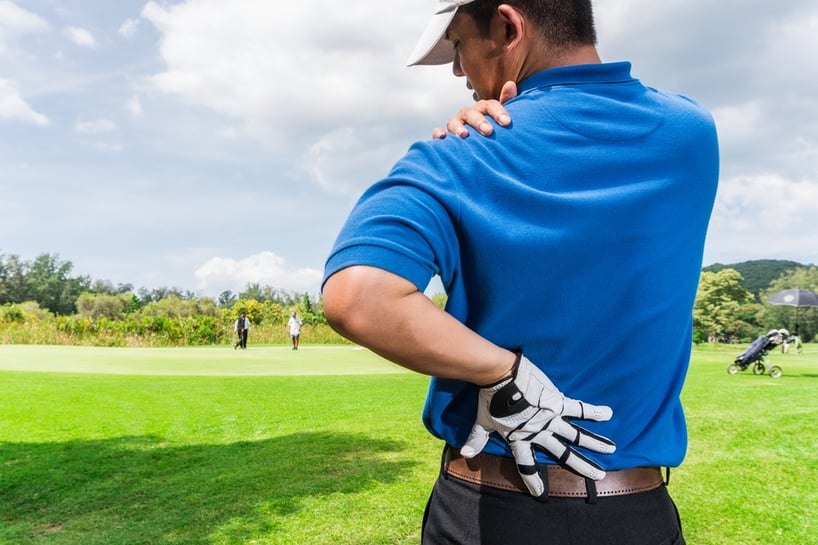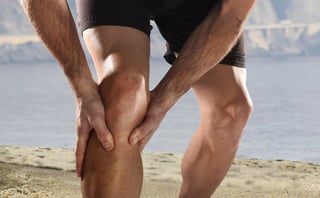The 5 Most Common Orthopedic Injuries in People over 40
February 23rd, 2017 | 5 min. read


Around middle age, our bodies begin to respond to wear and tear differently. Though everyone’s different, for many of us, noticeable differences start at around age 40. You may notice that injuries happen more easily — and heal more slowly — than when you were in your teens and twenties.
In fact, acute or chronic injuries bring many people over 40 to the orthopedist for the first time in their lives. An overambitious day of golf might lead to shoulder pain or immobility. Training for a road race may result in shin splints or stress fractures. Just walking up and down stairs might trigger knee soreness, buckling, grinding sounds, or stiffness.
If you’ve been active your entire life (or even if you haven’t), suddenly getting hurt while doing things that used to be easy is frustrating.
Why does it happen?
Why You Injure Yourself More in Your Forties
As you approach middle age, your muscles, bones, and joints change composition. Certain natural processes that help your body rebuild and strengthen begin to slow down, making injury more likely.
Here are a few facts you might not realize about your musculoskeletal system as it approaches, or passes, age 40:
- Bones lose mass. Most people, men and women alike, reach peak bone mass between the ages of 25 and 30. After age 40, we begin to lose bone faster than we can rebuild it. This leads to a lower bone density. Less dense bones become more fragile and susceptible to fractures, including stress fractures, crush fractures in the vertebrae (leading to humps or loss of height), and hip fractures (usually sustained during falls). Women in particular are prone to developing osteoporosis, though this is a bigger concern after the age of 70.
- Muscles lose mass, too. Muscle fibers diminish in number and size starting in our late 30s. Age-related muscle loss is a natural part of getting older. This process accelerates as we get on in years, especially in sedentary people. Smaller, weaker muscles are more likely to sustain injury, especially if you make big changes to your activity level rather than gradually building up strength through proper training and conditioning.
- Cartilage and tendon become drier. As we get older, the cartilage that cushions our bones and joints starts to hold less
 water. Drier cartilage is more susceptible to wear and tear when we move. As the cartilage rubs away, bone grinds against bone, which can lead to osteoarthritis and inflammation. Tendons — the fibrous collagen cords that attach muscle to bone — also become drier and stiffer, which can make them more likely to tear or rupture when overstretched.
water. Drier cartilage is more susceptible to wear and tear when we move. As the cartilage rubs away, bone grinds against bone, which can lead to osteoarthritis and inflammation. Tendons — the fibrous collagen cords that attach muscle to bone — also become drier and stiffer, which can make them more likely to tear or rupture when overstretched.
- Ligaments are less elastic. As we age, ligaments — the short bands of connective tissue that secure our bones and joints — become less flexible. As with aging tendons, aging ligaments are more likely to sustain damage when pushed past a certain point. This is why healing from a sprained ankle, for example, takes longer when you get older. Ligament tears in the knees and shoulders also become a bigger danger as we age.
- Some peoples’ bodies just age sooner. Though most of us start to heal more slowly at around age 40, there’s no set age at which bone, cartilage, tendon, and ligaments begin to degenerate. Lifestyle, diet, body weight, activity level, and genetics all play their parts. Even teens and young people in their 20s can experience arthritis symptoms due to earlier traumatic sports injuries or obesity. If you were rough on your body in your youth, you may have a greater than average level of wear and tear on your cartilage as you approach middle age. On the other hand, some people able to maintain rigorous activities without injuries well into their 80's.
Keeping these facts in mind, what musculoskeletal injuries do orthopedists see the most commonly in people in their 40s?
Top 5 Injuries in People Over 40
While arthritis and arthritis-related pain and stiffness is the #1 complaint of older middle age (around age 50 and up), the following activity-related injuries frequently lead people in their 40s to see an orthopedic specialist.
- Tennis elbow (and other weekend warrior injuries). After 40, repetitive strain and overuse injuries tend to be the #1 reason people visit orthopedists. Tennis elbow, or lateral epicondylitis, is one of the most common of these complaints. This overuse injury affects the tendons in the outside of the elbow joint. If you’re experiencing weak grip strength and a painful soreness or burning sensation in the outside of the elbow, you may have this condition. Tennis elbow can be a sports injury, as the name implies, but it can also be caused by knitting, using a computer mouse, typing, doing yard work, playing a musical instrument, or repetitive use of tools hammers or screwdrivers. Anything you do over and over, for hours at a time, can lead to an an overuse injury like tennis elbow. Tendonitis in other parts of the body is also commonly seen in people over 40 — for example, rotator cuff tendonitis, and Achilles tendonitis.
- Stress fractures. These thin, hairline fractures are caused by repetitive impact force, and overuse. Stress fractures are most common in the weight-bearing bones of the lower leg and foot. For example, road runners over 40 may develop stress fractures in their shins, brought on by a combination of impact (running on a hard asphalt surface) and loss of bone density. You may be more prone to develop a stress fracture when taking on a new exercise regimen, and doing too much too quickly.
- Lower back problems. Many people (especially men) develop back problems in their 40s, due to a combination of risk factors including a sedentary lifestyle, obesity, arthritis, and a loss of bone density. Slipped discs, disc degeneration, and spinal stenosis may sometimes require decompression or stabilization surgeries. Sciatica (a nerve issue that leads to numbness and discomfort in the hips and legs) is also a common complaint in both men and women.
- Rotator cuff tears and bicep tendon injury. The rotator cuff is the part of your shoulder joint that allows you to lift and rotate your arm. Over time, normal wear and tear in the shoulder joint weakens the dominant shoulder, especially in people who perform frequent tasks that require overhead motions (for example, swinging a hammer, painting, climbing, or throwing). You can also sustain rotator cuff tear from an acute injury, like a fall. About 2 million people per year sustain this injury. Bicep tendon injury is also more common in middle age, and often results from heavy lifting.

- ACL tears and meniscus tears. Age-related tissue degeneration makes the knee joint particularly susceptible to injury. If you’ve put on extra weight as you’ve gotten older, this added stress can also contribute to knee problems. Due to biomechanics, hormonal changes, and some medications, women are anywhere from two to 10 times as likely as men to sustain ACL (anterior cruciate ligament) tears and ruptures — and this likelihood increases after 40. ACL tears and ruptures can happen when you land awkwardly after jumping, when you pivot or twist your body with your feet in a fixed position, or when you sustain an impact to your knees while your feet are planted. As for meniscus tears, after 30, both men and women alike are prone to damaging the rubbery, disc-shaped "shock absorber" cartilage inside the knee joint. Meniscus (cartilage) tears can happen playing sports, but many people over 30 tear their menisci doing everyday activities like climbing and descending stairs, hiking, kneeling or squatting, or walking on cobblestones or a rough terrain.
Summary: When to See an Orthopedic Physician
All of the above injuries are more common as we age, and many if not all can lead to reduced function and mobility. Ignoring an injury can make it worse, and carrying on as normal can even lead to additional injuries as you adjust your posture and movement to favor an injured area.
In worse-case scenarios, soldiering on with an injury can compound your current problem and hasten the onset of additional tissue or bone degeneration, leading to disability and the need for surgery.
Your best bet, if you’re injured, is to see an orthopedic physician. Don’t ignore your discomfort and carry on with your daily activities, “business as usual.” An orthopedist can diagnose your condition and let you know if simple RICE therapy (rest, ice compression, and elevation) will do the trick, or if you may need to be more active in repairing your injury or addressing its root cause.
Article written by: Rob Williams, MD
Dr. Williams has been practicing orthopedic surgery in Corpus Christi since 1998. After graduating from Texas Tech hereceived his medical degree from the University of Texas at San Antonio. At the prestigious Campbell Clinic located at the University of Tennessee, Dr. Williams completed not only an Orthopedic Surgery Residency, but an additional year of Fellowship Training in Spine Surgery. Dr. Williams is dedicated to creating an excellent patient experience in the office or in the surgery suite.
Topics:

